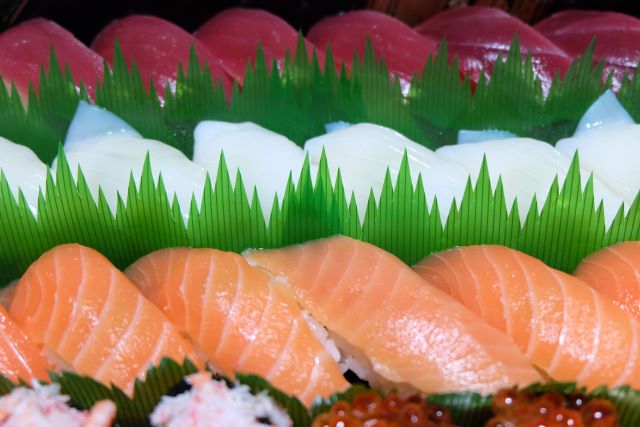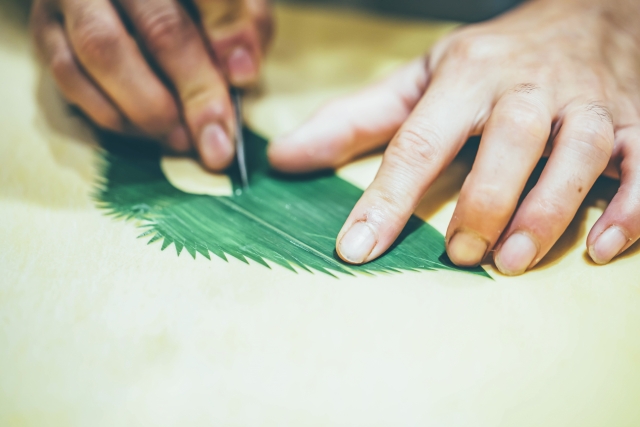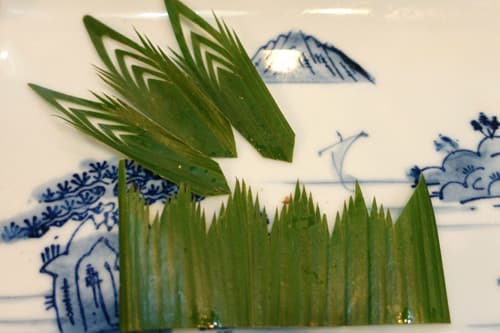
The jagged-cut sheet is a plastic baran.
If you’re intuitive, you may be thinking that the plastic, jagged sheet that is placed in between sushi and sashimi is some sort of decoration or used for separating them.
That’s exactly right.
It’s used to divide different types of sashimi and sushi. It’s a consideration of the chef to prevent the flavors and smells from transferring so that they will remain delicious for the customer.
But why is it green?
If you’re intuitive, you may have imagined that it is supposed to be some sort of plant.
That’s right too.
It’s a plastic replica of a Sasa (Broadleaf bamboo) or Haran (Aspidistra elatior). Also, most sashimi is red or white, so adding some green drastically improves the appearance and this appearance is also said to improve appetite.
So why is it jagged?
There is a reason for this. It is actually a type of design called “Yama-kiri” and is basically always used as a separator in Hako-zushi. In other words, a knife is used specifically to decorate it as Sasa or Haran. This is therefore called “Sasa-kiri” or “Haran-kiri”.

Haran (Aspidistra) is used as a vessel to serve sashimi and sushi.
When Edomae sushi was invented between 1804 and 1830, Sasa and/or Haran (also called Baran) was vital to sushi. It was used not only to keep under the sushi or to separate it, the Sasa and Haran used have bactericidal effects, aiding in keeping the sushi from spoiling. In the Edo era, there was also no access to running water and less-than-hygienic environments, so Sasa and Haran were used often back then according to the knowledge of the people at the time.

Sasa (Broadleaf bamboo)-kiri has long been a training ground for knife skills.
It is said that the role of Sasa-kiri and Haran-kiri as a decoration for sushi grew with the times, and it continued to be developed as the knife skills of sushi chefs improved. The reason for having both Sasa-kiri and Haran-kiri, despite being used for the same purpose, is that Sasa was used for Edomae sushi while Haran was used for Osaka sushi (mainly for Hako-zushi). One reason is that Sasa grew more in the north, especially around Kanto, while Haran grew more in the south, especially around Osaka. Haran was also widely used in Osaka, such as to place under Hako-zushi and to separate sushi. Since Sasa wilts easily, it was also useful in gaging the freshness of the sushi. In other words, consuming the sushi before the Sasa wilted was a way to ensure that the sushi was still delicious and safe.
In recent years, there are more and more restaurants using plastic instead of fresh Sasa and Haran. Especially for delivery and takeout sushi, plastic is preferred because it won’t wilt and maintains its colorful appearance over time. There are also size limitations for Sasa and Haran, but plastic allows for a wide variety of sizes and cuts. Plastic became widely used because of its convenience, but it can’t replicate the unique fragrance and texture of fresh Sasa and Haran. Most of all, the level of satisfaction of customers when they are served sushi decorated with real Sasa-kiri and Haran-kiri is something that can’t be replicated with plastic. Sushi is a food that represents Japanese culture and in the same way, Sasa-kiri and Haran-kiri are also Japanese culture. Continuously maintaining this skill is also an important role of modern-day sushi chefs.
To summarize, the original form of this jagged-cut sheet was Sasa-kiri and Haran-kiri.
Incidentally, the plastic versions were originally called “Jinzo Haran” (artificial Haran) and at some point, “Rendaku” was applied and it was eventually known as “Jinzo-baran” from which “Jinzo” was eventually dropped so it is now called “Baran.” In other words, the plastic version is Baran. Haran-kiri is cut Haran. Cut Sasa is called Sasa-kiri.
Share this article